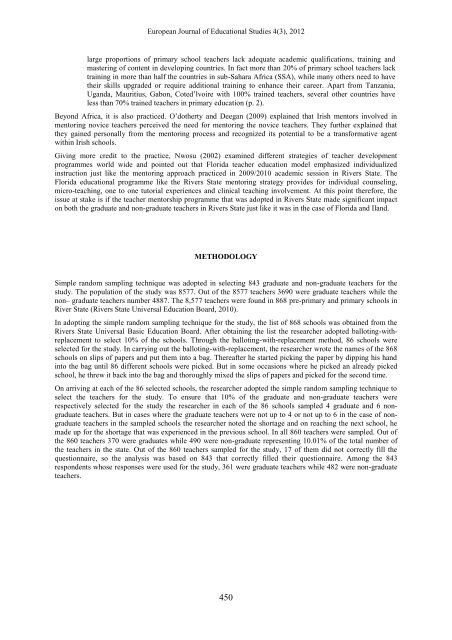Volume 4 Issue 3 (October 2012) - Ozean Publications
Volume 4 Issue 3 (October 2012) - Ozean Publications
Volume 4 Issue 3 (October 2012) - Ozean Publications
Create successful ePaper yourself
Turn your PDF publications into a flip-book with our unique Google optimized e-Paper software.
European Journal of Educational Studies 4(3), <strong>2012</strong><br />
large proportions of primary school teachers lack adequate academic qualifications, training and<br />
mastering of content in developing countries. In fact more than 20% of primary school teachers lack<br />
training in more than half the countries in sub-Sahara Africa (SSA), while many others need to have<br />
their skills upgraded or require additional training to enhance their career. Apart from Tanzania,<br />
Uganda, Mauritius, Gabon, Coted’lvoire with 100% trained teachers, several other countries have<br />
less than 70% trained teachers in primary education (p. 2).<br />
Beyond Africa, it is also practiced. O’dotherty and Deegan (2009) explained that Irish mentors involved in<br />
mentoring novice teachers perceived the need for mentoring the novice teachers. They further explained that<br />
they gained personally from the mentoring process and recognized its potential to be a transformative agent<br />
within Irish schools.<br />
Giving more credit to the practice, Nwosu (2002) examined different strategies of teacher development<br />
programmes world wide and pointed out that Florida teacher education model emphasized individualized<br />
instruction just like the mentoring approach practiced in 2009/2010 academic session in Rivers State. The<br />
Florida educational programme like the Rivers State mentoring strategy provides for individual counseling,<br />
micro-teaching, one to one tutorial experiences and clinical teaching involvement. At this point therefore, the<br />
issue at stake is if the teacher mentorship programme that was adopted in Rivers State made significant impact<br />
on both the graduate and non-graduate teachers in Rivers State just like it was in the case of Florida and Iland.<br />
METHODOLOGY<br />
Simple random sampling technique was adopted in selecting 843 graduate and non-graduate teachers for the<br />
study. The population of the study was 8577. Out of the 8577 teachers 3690 were graduate teachers while the<br />
non– graduate teachers number 4887. The 8,577 teachers were found in 868 pre-primary and primary schools in<br />
River State (Rivers State Universal Education Board, 2010).<br />
In adopting the simple random sampling technique for the study, the list of 868 schools was obtained from the<br />
Rivers State Universal Basic Education Board. After obtaining the list the researcher adopted balloting-withreplacement<br />
to select 10% of the schools. Through the balloting-with-replacement method, 86 schools were<br />
selected for the study. In carrying out the balloting-with-replacement, the researcher wrote the names of the 868<br />
schools on slips of papers and put them into a bag. Thereafter he started picking the paper by dipping his hand<br />
into the bag until 86 different schools were picked. But in some occasions where he picked an already picked<br />
school, he threw it back into the bag and thoroughly mixed the slips of papers and picked for the second time.<br />
On arriving at each of the 86 selected schools, the researcher adopted the simple random sampling technique to<br />
select the teachers for the study. To ensure that 10% of the graduate and non-graduate teachers were<br />
respectively selected for the study the researcher in each of the 86 schools sampled 4 graduate and 6 nongraduate<br />
teachers. But in cases where the graduate teachers were not up to 4 or not up to 6 in the case of nongraduate<br />
teachers in the sampled schools the researcher noted the shortage and on reaching the next school, he<br />
made up for the shortage that was experienced in the previous school. In all 860 teachers were sampled. Out of<br />
the 860 teachers 370 were graduates while 490 were non-graduate representing 10.01% of the total number of<br />
the teachers in the state. Out of the 860 teachers sampled for the study, 17 of them did not correctly fill the<br />
questionnaire, so the analysis was based on 843 that correctly filled their questionnaire. Among the 843<br />
respondents whose responses were used for the study, 361 were graduate teachers while 482 were non-graduate<br />
teachers.<br />
450

















